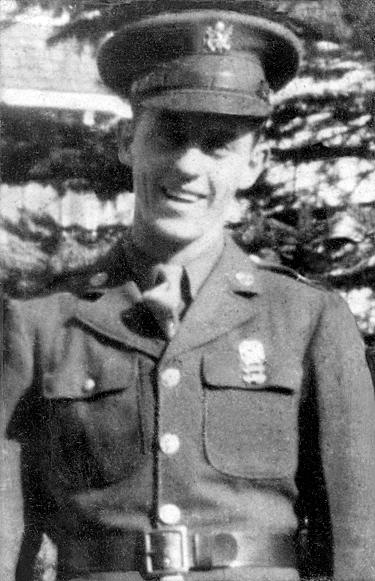

Sergeant Ernest Lavoie
Company A 1st Battalion 22nd Infantry
4th Infantry Division
DOW July 29, 1944
Ernest Lavoie was born in Fall
River, Bristol County, Massachusetts in 1925. He was drafted into
the Army
on June 10, 1943, at Boston, Massachusetts. He had completed
Grammar School, and listed his
civilian occupation as Checkers. He was engaged to be married.
His religion was listed as Catholic.
He spent part of his stateside training in Company K, 3rd Battalion, 409th Infantry Regiment, 103rd Infantry Division.
He was assigned to Company A as
a Private First Class, from the 4th Infantry Division replacement
pool
on June 17, 1944.
He was an exemplary soldier,
attaining the rank of Sergeant in a shorter period of time than
was usual in those days.
On July 1, 1944 Ernest Lavoie was promoted on the battlefield in
Normandy from Private First Class directly to Sergeant.
Sergeant Ernest Lavoie died of
wounds received in action on July 29, 1944, during Operation
Cobra,
the breakout from the Normandy hedgerow country, in France. He
was nineteen years old.
During the battle in Moyon,
France, Sgt. Lavoie was struck in the thigh by shrapnel and was
evacuated from
the front lines to the 41st Evacuation Hospital. He died the same
day he was wounded on July 29th, 1944.
The cause of his death was a hemorrhage of the femoral artery.
His record of casualty was not listed in the
morning reports for Company A until August 11, 1944.
On 29 July 1944, the 22nd
Infantry Regiment was attached to the 2nd Armored Division as
part of Task Force Rose.
They were the spearhead of the St. Lo breakout and earned
the Presidential Unit Citation for their actions during this
operation.
The following narrative describes the events during which SGT Lavoie lost his life:
"Interview
with officers of 1st Battalion, 22nd Infantry, Major Robt B.
Latimer, CO,
and Captain Frank B. Reid, CO, Co C, 22nd Inf. on 10 August 1944.
The following
events took place in Moyon, France.
On the 29th our tanks tried to get through the town to the south.
But German fire knocked one out on the
road to the southeast, another out on the road to the south thus
blocking both roads. The Colonel of the
armored force (who was commanding) now decided that since the
enemy held such strong positions south of
the town he would withdraw the infantry in order to blast the
Germans with an artillery barrage. This
withdrawal was under way when Major Latimer learned of it.
Knowing very well what would be the result of
pulling out of the town he conferred with the Colonel and it was
decided to reoccupy the ground. However
the Germans had already moved in on the heels of our men. The
infantry never succeeded in recovering all
the ground they had given up.
Strong forces of German tanks had now come in just south of the
lines in addition to those who were dug in
there. A duel developed between these German tanks and ours with
the infantry in between. This was the
worst punishment the battalion has ever taken. We lost very
heavily in this whole battle, somewhere around
50% of the assault companies and the greatest part of the loss, I
believe, was suffered when we were caught
in the tank duel.
We had actually seen perhaps two dozen German tanks during this
battle and apparently there were others. A
prisoner stated that they had eight Panzer companies in this
action. They also used a great deal of artillery; I
believe it was the most we have ever encountered. We had quite a
few men crack up as a result of the fire they
were under in this battle, and so did the armored forces.
Co A had a
platoon on the right flank. A German tank came up the road from
the south and fired heavily for
some time on this platoon knocking out all its men but eleven.
Late on the 29th we were relieved at Moyon by the 116th Infantry.
Just after all our troops had cleared the
town except Capt. Reid with five men who had stayed to confer
with the relieving company commander, the
Germans bombed the town. They had got their own lines as well as
the 116th. They had dropped flares over
the American lines but these had drifted back over the Germans
which probably caused their bombing error.
We were glad to see that the Germans can make mistakes too.
Co A loaded on tanks and attempted to move out on the road
running west. But the Germans had this road
so well entrenched, including tanks dug in, that they were unable
to get through. The entire battalion moved
back to the north. On July 30th the battalion was moved to
Villebaudon. A heavy and accurate shelling by the
Germans from their hill positions to the east prevented us from
moving on the highway. We turned off to the
west and continued down secondary roads to Villebaudon. I had
hated to leave Moyon without finishing the
job there. I think we had the Germans groggy from the hammering
we had given them and they were just
about ready to give up. But as it was we reached Villebaudon just
in the nick of time."
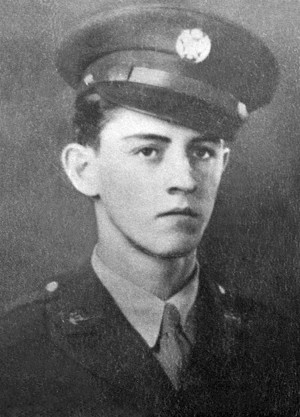
Ernest Lavoie
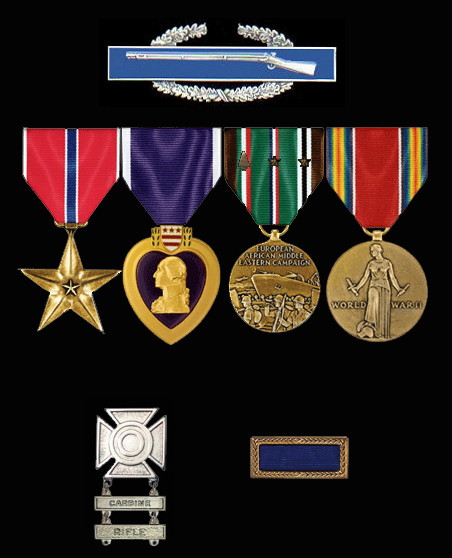
Sergeant Ernest Lavoie's decorations
Through the dedication and hard work of
SGT Ernest Lavoie's great-nephew John Tomawski, who submitted
repeated requests to the Army Review Board on behalf of his
great-uncle, the above decorations have been
officially entered into the personnel record of Sergeant Ernest
Lavoie, some seventy years after SGT Lavoie
made his ultimate sacrifice in the service of his country.


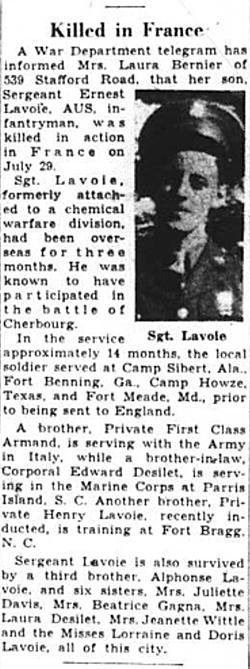
SGT Ernest Lavoie was buried in
the temporary American Military Cemetery,
La Cambre Cemetery at Isigny, France in Block AC Row 6 Grave 112.
He was later re-interred in the cemetery at Colleville-sur-Mer
(originally called
St. Laurent) most likely in the 1947-1949 time period when the
temporary
cemeteries were shut down and remains of American dead were
relocated
to the permanent cemeteries or returned to the United States.
Burial:
Normandy American Cemetery and Memorial
Colleville-sur-Mer
Departement du Calvados
Basse-Normandie, France
Plot H Row 8 Grave 25
|
The American cemetery The grave marker for SGT Ernest
Lavoie Photo courtesy of John Tomawski |
The grave marker for SGT Ernest Lavoie Photo courtesy of John Tomawski |
|
In October 2014, seventy years
after the death of Ernest Lavoie, his great-nephew John Tomawski
traveled to France to visit the village where Ernest died. John
met with the Mayor of Moyon,
the scene of the battle in which Ernest received his mortal
wounds, and visited the cemetery where
Ernest is buried. John had previously secured Ernest's
decorations from the Army and placed
them on Ernest's grave marker.
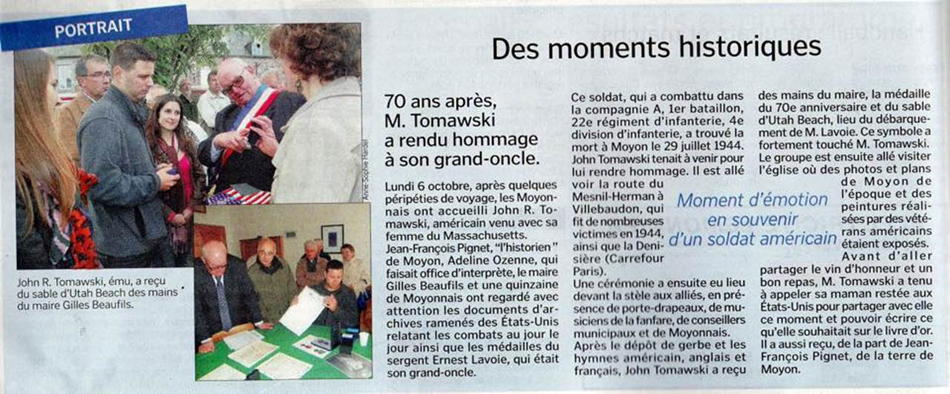
Newspaper article about the visit of
John Tomawski to Moyon in honor of his Great-uncle Ernest Lavoie.
John is seen meeting with the Mayor of Moyon and other
dignitaries and receiving an example of sand
from Utah Beach by the Mayor.
Translation of above article:
70 years after, Mister Tomawski has paid tribute to his great-uncle.
Monday 6 October, after several
travel adventures, the people of Moyon welcomed John R. Tomawski,
an American who came with his girlfriend from Massachusetts.
Jean-Francois Pignet, the
"historian" of Moyon, Adeline Ozenne, who was acting as
an interpreter, Mayor
Gilles Beaufils and fifteen people from Moyon attentively looked
upon the archival documents brought from
the United States relating the day to day fighting as well as the
medals of Sergeant Ernest Lavoie, who was
his great-uncle.
This soldier, who fought with
Company A, 1st Battalion, 22nd Infantry Regiment, found death in
Moyon
on July 29, 1944. John Tomawski was anxious to come to pay
tribute to him. He went to see the route
from Mesnil-Herman to Villebaudon, which caused many casualties
in 1944, as well as La Denisière
(at which was the crossroads leading to Paris).
Moment of emotion in memory of an American soldier
A ceremony was then held in
front of the monument to the Allies, with flag bearers present,
musicians
from the band, municipal councilmen and people of Moyon.
After the laying of a wreath and
the American, British and French national anthems, John Tomawski
received from the hands of the Mayor the medal of the 70th
Anniversary and sand from Utah Beach,
the place where Mister Lavoie landed. This symbol greatly
affected Mister Tomawski. The group then
visited the church where photos and blueprints of Moyon from that
time and paintings made by American
veterans were on display.
Before going to share the wine
of honor and a good meal, Mister Tomawski held a call with his
mother
who had remained in the United States to share with her this
moment and to find what she wanted to write
in the guestbook. He also received, from the hand of
Jean-Francois Pignet, earth from the city of Moyon.
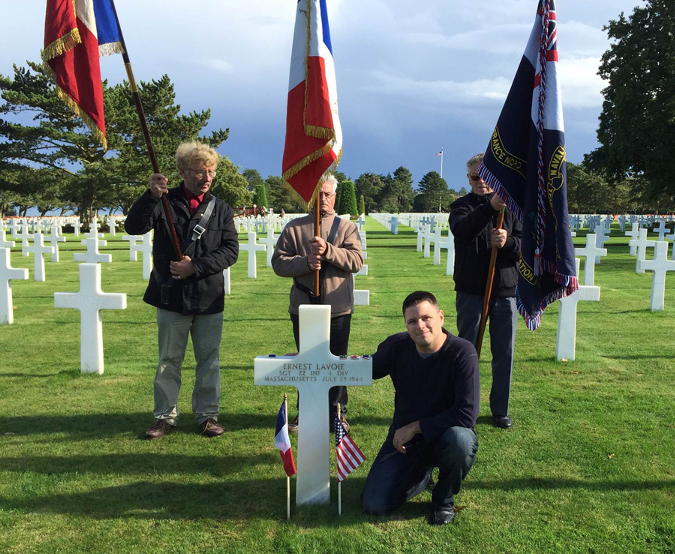
John Tomawski at the grave of Ernest Lavoie with French flag bearers in the background.
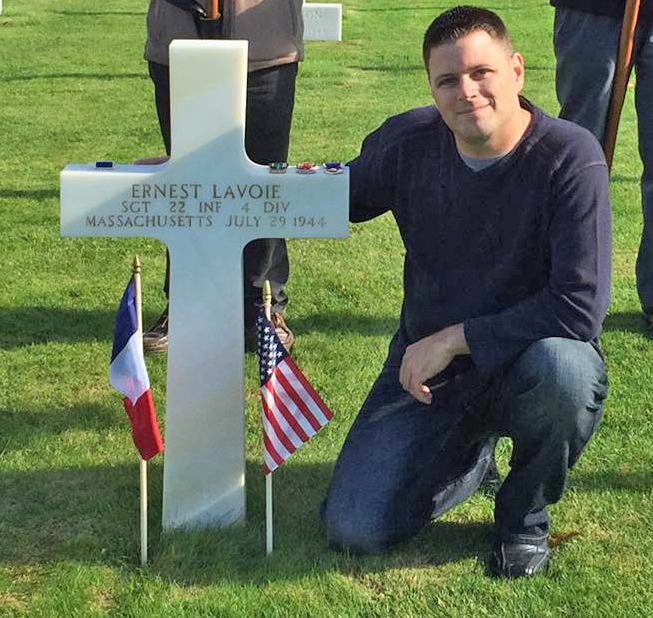
The decorations earned by SGT Ernest
Lavoie rest on his grave marker in the American Cemetery in
Normandy,
placed there by his great-nephew John Tomawski, seen here next to
the grave.
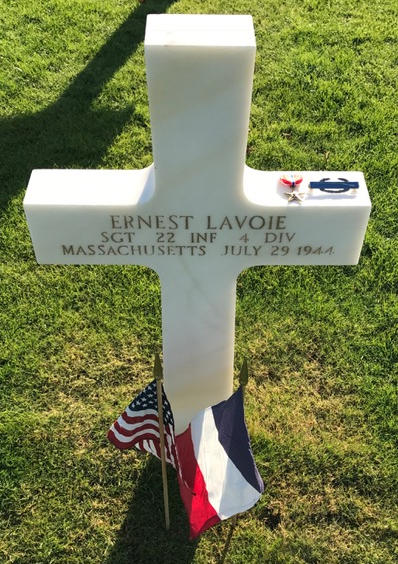
After further investigation the Army
Review Boards Agency determined that
SGT Ernest Lavoie was authorized the Combat Infantryman Badge and
the
Bronze Star Medal. In October 2016 John Tomawski returned to the
grave of
SGT Lavoie in Normandy and placed those additional decorations on
his grave.
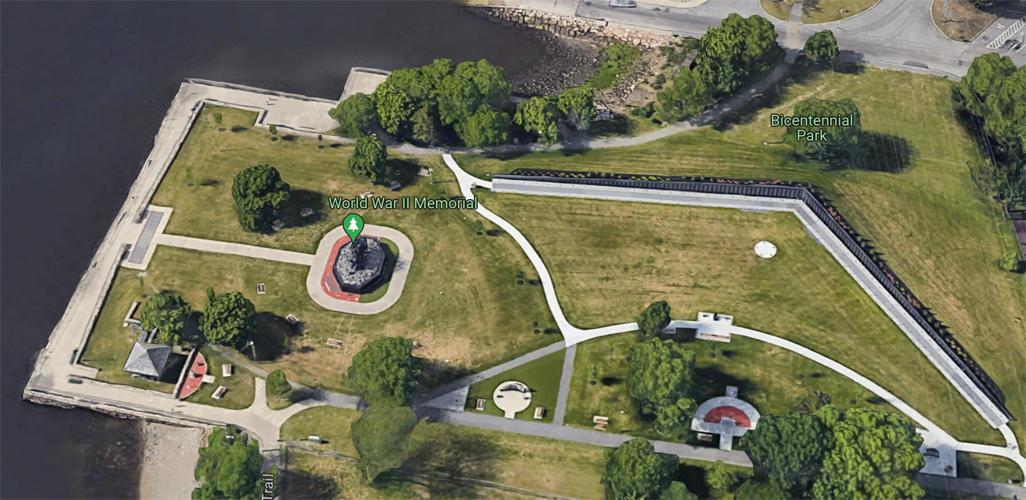
Above: Bicentennial Park in Fall River,
Massachusetts.
In the photo "World War II Memorial" indicates the Iwo
Jima memorial replica statue.
In front of the statue is the area of stone pavers, one of which
contains the name of Ernest Lavoie.
Photo courtesy of John Tomawski
|
Left: The Iwo Jima memorial replica
statue In front of the statue are the
stone pavers, Photo courtesy of John Tomawski |
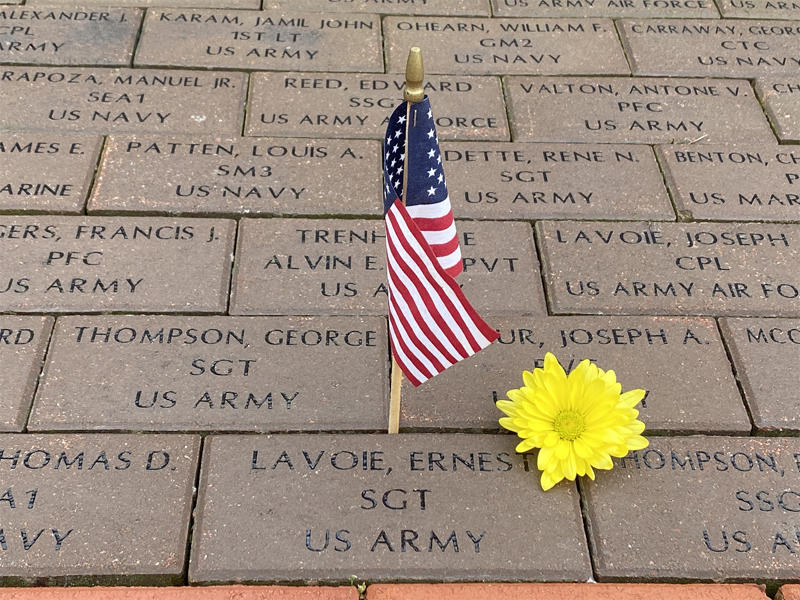
The stone paver with the name of Ernest Lavoie, marked by an American flag and flower.
Photo courtesy of John Tomawski
Photos and article from John R. Tomawski
in honor of his Great-Uncle, Ernest Lavoie
Home | Photos | Battles & History | Current |
Rosters & Reports | Medal of Honor | Killed
in Action |
Personnel Locator | Commanders | Station
List | Campaigns |
Honors | Insignia & Memorabilia | 4-42
Artillery | Taps |
What's New | Editorial | Links |